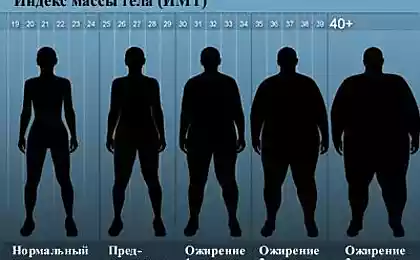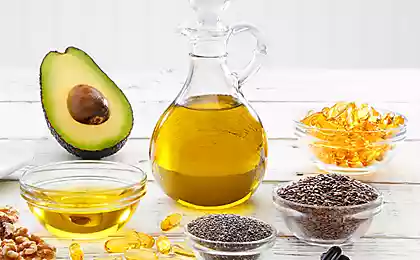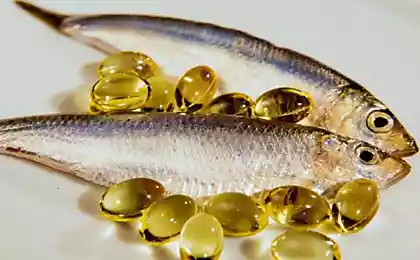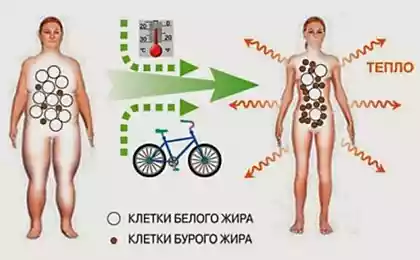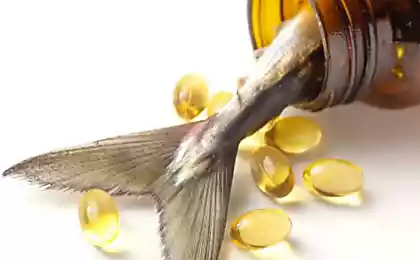698
Learn why we need fat: 4 functions in the body
Fats and their functions in the human body
Fats perform 4 functions in the body:
1) the most important feature is the participation of fats in our breath,
2) restoration of cell membranes of the body, and we have more than hundreds of trillions,
3) fats are involved in hormone synthesis,
4) fat is the energy function of the body.
Forty six million two hundred twenty two thousand three hundred twenty
Understanding the importance of fat, you will not deliberately avoid them, sitting on a low-fat diet.
If still there is doubt and you don't want to eat fat, at least in order to protect the will take a fat-containing food additives the best of which are the omega 3/60 or omega 3-6-9 and Lecithin.
Especially about fats it is important to know the climbers and the people who work in a small amount of oxygen, and masters of manicure, barbers, builders, residents of cities, those who have a sedentary lifestyle and those who have diseases of the respiratory system.
Next, a little more about the functions of fats in our body.
Fats are involved in breathing
Once born the child, the first thing he does is breath. If the baby's lungs do not receive oxygen — his life is immediately interrupted. Therefore, the mechanism of the first breath – this is the main point from which we begin our lives.
The body of this very well know and really wants to ease the mechanism of oxygen that then would accompany us the entire life.
All the cells in our body need oxygen. If oxygen is not received, then after 1 minute the cells begin to die after 2-3 minutes they are already in principle and did not return to life even if we'll give them oxygen. After 5 minutes – it is biological death that is not reversible.
Our body has developed a protection system, not to leave us without oxygen even for a second. This system is in the lungs. If we consider the bronchial tree, you can see that the bronchi to the periphery is reduced to the bronchioles, and each bronchiole on your tip has a bubble is called alveolus. This breathing bubbles that contain air. They are not blown. Its airy light obtained by air bubbles that are in the alveoli. Most importantly, these alveoli all our lives were in the expanded state.
Surfactant
An amazing substance that provides us this feature covers the inner side of the alveoli and it is called surfactant, which is 99% fat and 1% protein.
All of us since the first breath I breathe with a light layer of surfactant. If we have it and it is good quality, then we breathe easy, digesting the oxygen within a fraction of a second. As soon as the surfactant of the alveoli are gone for various reasons, such alveoli we can't transfer the oxygen and the respiratory surface of the lungs is reduced.
When they began to study the processes of fat metabolism, found — the first thing is to provide food the fat we eat, is to go to a function of the surfactant and provide us breathing.
As we digest fats
All the fats that we eat, our body is wrong and they need to be broken down in our intestines by the enzyme protein Lipase. This enzyme breaks down fat molecules to fatty acids.
The only trouble fatty acids that they are very large, their molecules is enormous. These molecules should not enter the blood vessels, because it can clog their blood vessels will not function. Get the status of fat embolism.
Wise mother Nature has crafted a separate system of suction, which is called lymph. All large molecules are absorbed we in the lymphatic system and continue with the flow of lymph moving in the place where they should be used.
The body remembers that together with the large molecules can slip through the bacterium. So the way of the flow of lymph, the body builds blog-posts that are called lymph nodes through which lymph is filtered. If there is bacteria, then they linger in knots and can't penetrate further into our internal environment.
Here are the immune cells lymphocytes. All lymphatic vessels, which otmechayut from the intestine into the lymphatic system, it collects fats from our intestines into a common lymphatic duct, which empties into the left subclavian vein. In this place we fats is not dangerous. Because the subclavian Vienna has a constant height, it is fixed clavicle.
When a person dies from the shock, all the veins in his collapse, and the only place to get is in the subclavian vein, which punctured resuscitators, placing subclavian catheters.
In this place we have a common lymphatic duct empties all fats after absorption in the intestine (only a small part is spent on lymph nodes) into the venous blood, and venous blood we are, first and foremost, to the lungs to give oxygen and blood to become, and then spread throughout the body.
The venous blood arriving in the lungs is rich in carbon dioxide and rich in fat. Together with oxygen, the fats begin to penetrate through the membrane of alveolocytes and form a layer of surfactant.
Not coincidentally, our body sends the fat in the lungs is the first place where we need them. The alveoli take away the fats, are synthesized from them the surfactant and after, we have secured ourselves in terms of breathing, the remnants of fat with arterial blood already beginning to spread throughout the body.
If 100% of the alveoli is provided a surfactant — our breath is
The state of oxygen deficiency is called hypoxia
This condition is equivalent to the diseases of civilization, because a huge number of people have a deficiency of surfactant structures. And that all the people who are on low-fat diets.
The decrease in the level of surfactant influence:
Surfactant I love bacteria, viruses, fungi, protozoa.
Surfactant very fond of roundworm (their development cycle begins with light!).
A partial symptom of hypoxia is low blood pressure 105/65.
Hypotensive is people with impaired surfactant function with respiratory failure in the alveolar part of the lung.
The most vulnerable surfactant is a newborn
If a woman during pregnancy deprived fat, the child definitely be born with surfactant deficiency. This means that the lungs will breathe poorly, they sit some kind of infection.
If not enough oxygen, the brain begins to suffer.
Sometimes we see that a person has a problem with all bodies. This occurs when not enough oxygen and all the cells sit on a starvation diet. The only way to improve matters is to appoint a person fats. To ensure the absorption of fatty acids in the lymph, to ensure the synthesis of surfactant and then the person starts to breathe properly. Disease miraculously begin to retreat.
In the past 15 years, healthy children are born small because 30 years popular low-fat diet. Girls are naive to think that obesity depends on dietary fat.
Obesity of dietary fat does not. Obesity depends on the carbs.
After of the fat went to the function of surfactant, the remnants of which we have not demanded light, begin to circulate. These residues of fatty acids should not be in our vessels in the free state, because there's a blockage, atherosclerosis and the deposits on the walls of blood vessels.
Therefore, the body begins to bind to transport proteins and begin to form complexes, called lipoproteins. It is those substances that takes the doctor by studying our fat metabolism. Is the cholesterol test.
Cholesterol
Cholesterol is divided into 3 groups:
1. High density lipoproteins HDL
2. Low density lipoproteins LDL
3. Lipoproteins of very low density
Lipoprotein is the fat-protein. It all depends on how this molecule transport protein:
1. If fat 20-30% and proteids 70-80% then it's high density. The molecule is a dense, well-Packed fat, so the fat comes to the place where it is needed and this cholesterol doctors call "good".
2. If the molecule fat molecule 50-60%, and proteids 40-50%, then the density of this molecule is reduced and the lipoprotein is low density. And it is dangerous.
3. But even more dangerous, if the density is even lower, when fats become 80% and protein 20%. This creates a situation where we are on a little cart driven 10 ton, and on every bump the truck bounces and the product of it falls out. Similarly, molecules of very low density fats begin to fall out at the place of shipment.
Opustanje that such low density of fat is called bad cholesterol. The more of these fats, the greater the risk of atherosclerosis and zarastaniya of our vessels gross fats.
Fat matter?
It's not fats, and proteins in the transport of blood. The more transport protein in the blood, the higher we have of high-density lipoproteins, the more we have of good cholesterol. And the higher we depleted molecules, the higher the bad cholesterol.
It's called improving the atherogenic coefficient (KA). This ratio of high and low molecules. If KA is greater than 3 (for each the molecule has 3 of these and it is bad. And when these 5, but these 2, then everything is perfect).
Therefore, atherosclerosis is not a problem of fat metabolism. This is an area of deficiency of the transport protein.
Fats and restoration of cell membranes in continuous mode
Proteins form the cell, all the cells are protein structures, and here the sheath cells – a layer of fat.
The body builds around every cell double layer of lipids to protect cells from the threats from the external environment.
As for our cells external environment is the extracellular space, respectively, the cell membrane protects it from aggressive factors in the intercellular space, and in fact, the health of the cells, as the protein structure depends on the function of membranes consisting of fats.
Now a huge number of cardiovascular diseases, a huge number of arrhythmias. Many people take drugs potassium, iodine, magnesium, vitamins and minerals, but they have to understand, if we have enough transport protein and we have a poorly functioning membrane, no trace elements will not be in the cage. They will be deposited in other places, to accumulate in the extracellular space and the cell was in a state of deficit will remain.
To avoid this harmful situation, we must remember that the membrane is not less important than the function of the protein cells. If all of the diaphragms are working well, we will never have a deficit, and most importantly, we will never have detention space in the tissue of toxins and water.
And what is the water in the extracellular space? This edema, which affects about 60% of people. And many who consider themselves fat actually people swollen.
And full people begin to take drugs with fat-burning effect, sit on a low-fat diet, getting hard to breathe and instead of desired weight loss, nabirat 2 times more.
Edematous syndrome no relation to obesity has not. The only thing to do to people with edematous syndrome is to normalize the status of their membranes to water them well left of the fabric.
Fats and the synthesis of hormones
The following function of fats and the synthesis of hormones.
People are divided into men and women, respectively divide them into estrogens and testosterone.
And these sex hormones are synthesized we come from the same fat from cholesterol. If there is no cholesterol, no man will have a normal level of testosterone. One of the most extreme standards of violations of cholesterol metabolism, a decrease in the function of fats in the body is reduction of testosterone in men and the occurrence of diseases such as adenoma and prostate cancer, there appears oxidized testosterone, which causes a neoplastic disease.
In women the same can be said about estrogen functions. Now many women with breast cancer, uterine cancer etc. Almost all of this is considered dishormone tumors.
Again, from the point of view of nutrition, it all depends on the quantity of fats that is consumed with food, their quality and their adequacy.
Twenty seven million one hundred ninety seven thousand five hundred fifty
The energy function of fats
You can still talk about fats as a source of energy.
All daily carbs that we can't spend, a person carefully stored. Our body lives by the principle: "I don't know what will happen tomorrow, but on a rainy day I'll put a little bit of excess".
And excess carbohydrates goes into the fatty cells that are in each of us and stored as fat. Therefore, obesity, which all fear is the obesity from excess carbohydrates.
Most interesting is that exchanges fat for a long time doing. Consume a lot of fat Northern people (Chukchi, Evenki). In the 70 years the Americans began to study the theory about the dangers of fat by way of example of the Evenks. Revealed that their diet fats take up to 60% ( animal fat seals, walruses, very fatty Northern fish) and 40% protein. Like, with this ratio of fat and protein and this diet they should die from atherosclerosis. However, it appears that among the Northern Nations the lowest percentage of ateroscleroza.
"The North and Vysokogornaya a person lives, the greater the percentage of fat should be in his diet."Because the higher and farther North we live, the more we need surfactant to breathe in cold air and provide oxygen.
And most importantly, that in the North the fats burn quickly, giving the energy. In this case, their consumption is so great that such ratios of dietary fat do not cause human phenomenon of atherosclerosis. Assuming of course that the transport proteins are not affected and no shortage of protein.
If this situation is to move South and find that southern people do not need this amount of fat."The farther South and closer to the equator we live, the less fats we need in the diet». For southern people the key factor is the provision of protein. If in warm areas well provided with protein, they will be all right with the fat metabolism. If there is a shortage of fats, they will increase LDL and very low density and the fats will begin to precipitate.
Therefore, from the point of view of fat, atherosclerosis is a disease transport proteins and disease of people living in warm komfornih conditions.
The second group of the vulnerability of fats is growing children. The child grows and it increases oxygen demand. The more the baby grows, the more it must be oxygen because all the functions of your memory and brain depend on it.
Does your child receive enough oxygen and does he have surfactant? He was, we must ensure that food sources of fat. First are eggs (protein + fats) in optimal proportions fatty fish, caviar, and the coarse fraction of cholesterol (fat, fatty meats), because these structures provide us with a good formation of membranes of nerve cells. It's practically pure cholesterol.
When the child grows up, you can reduce the amount of coarse fat and switch to vegetable fats, which have many unsaturated bonds, a molecule providing chemical reactivity. And here's to the fat molecules linked to free radicals and rid our the intercellular space of toxins and free forms of oxygen, we should switch to vegetable fats. For those who have more polyunsaturated fatty acids omega-3,6. Their source is fish oil and vegetable oil:
In regards to fats is the principle of constant change. If the case for the winter – increase the number of rude fat. If the fly plant.
Fat itself will never be added quickly (in 2 months 3 kg), and then by may-June will diminish.
And swelling – rapid weight gain (86 kg today and tomorrow 87 kg – walks on water fro 2-3 kg). It's an unstable weight. Symptom is not a sustainable scale — weight fluctuates all the time.
The second symptom of edema – flabby body.
Cellulite is a swelling of the adipose tissue, when in fat cells, in addition to the fats deposited there by natural means begin to be deposited toxins. Either the cells swell, if they start to change some structures and grow lipoma. It is a disease of adipose tissue and need to work with transport proteins.
Also interesting: overweight and sometim person
Cleansing of blood and lymph
Repeat, if we talk about fats, the best food Supplement, this fish oil:
If you take 1 capsule 2 times daily with meals — this will cover the daily need for surfactant. Ideal to take one day omega 3/60 and another day in Lecithin, especially in winter and especially children. published
According to the materials of the lectures nutritionist Konstantin Zabolotny
SUBSCRIBE to OUR youtube channel that allows you to watch online, download from YouTube free video about the recovery, the rejuvenation of man. Love for others and ourselves, as the feeling of high vibrations — an important factor in recovery —
http://cdn00.vidyomani.com/c/2/7/7/1bl1dhibo2rm/index.html
Put LIKES and share with your FRIENDS! https://www.youtube.com/channel/UCXd71u0w04qcwk32c8kY2BA/videos
Subscribe - https://www.facebook.com//
P. S. And remember, only by changing their consumption — together we change the world! ©
Join us in Facebook , Vkontakte, Odnoklassniki
Source: becoral.eu/zachem-nam-nuzhny-zhiry/
Fats perform 4 functions in the body:
1) the most important feature is the participation of fats in our breath,
2) restoration of cell membranes of the body, and we have more than hundreds of trillions,
3) fats are involved in hormone synthesis,
4) fat is the energy function of the body.
Forty six million two hundred twenty two thousand three hundred twenty
Understanding the importance of fat, you will not deliberately avoid them, sitting on a low-fat diet.
If still there is doubt and you don't want to eat fat, at least in order to protect the will take a fat-containing food additives the best of which are the omega 3/60 or omega 3-6-9 and Lecithin.
Especially about fats it is important to know the climbers and the people who work in a small amount of oxygen, and masters of manicure, barbers, builders, residents of cities, those who have a sedentary lifestyle and those who have diseases of the respiratory system.
Next, a little more about the functions of fats in our body.
Fats are involved in breathing
Once born the child, the first thing he does is breath. If the baby's lungs do not receive oxygen — his life is immediately interrupted. Therefore, the mechanism of the first breath – this is the main point from which we begin our lives.
The body of this very well know and really wants to ease the mechanism of oxygen that then would accompany us the entire life.
All the cells in our body need oxygen. If oxygen is not received, then after 1 minute the cells begin to die after 2-3 minutes they are already in principle and did not return to life even if we'll give them oxygen. After 5 minutes – it is biological death that is not reversible.
Our body has developed a protection system, not to leave us without oxygen even for a second. This system is in the lungs. If we consider the bronchial tree, you can see that the bronchi to the periphery is reduced to the bronchioles, and each bronchiole on your tip has a bubble is called alveolus. This breathing bubbles that contain air. They are not blown. Its airy light obtained by air bubbles that are in the alveoli. Most importantly, these alveoli all our lives were in the expanded state.
Surfactant
An amazing substance that provides us this feature covers the inner side of the alveoli and it is called surfactant, which is 99% fat and 1% protein.
All of us since the first breath I breathe with a light layer of surfactant. If we have it and it is good quality, then we breathe easy, digesting the oxygen within a fraction of a second. As soon as the surfactant of the alveoli are gone for various reasons, such alveoli we can't transfer the oxygen and the respiratory surface of the lungs is reduced.
When they began to study the processes of fat metabolism, found — the first thing is to provide food the fat we eat, is to go to a function of the surfactant and provide us breathing.
As we digest fats
All the fats that we eat, our body is wrong and they need to be broken down in our intestines by the enzyme protein Lipase. This enzyme breaks down fat molecules to fatty acids.
The only trouble fatty acids that they are very large, their molecules is enormous. These molecules should not enter the blood vessels, because it can clog their blood vessels will not function. Get the status of fat embolism.
Wise mother Nature has crafted a separate system of suction, which is called lymph. All large molecules are absorbed we in the lymphatic system and continue with the flow of lymph moving in the place where they should be used.
The body remembers that together with the large molecules can slip through the bacterium. So the way of the flow of lymph, the body builds blog-posts that are called lymph nodes through which lymph is filtered. If there is bacteria, then they linger in knots and can't penetrate further into our internal environment.
Here are the immune cells lymphocytes. All lymphatic vessels, which otmechayut from the intestine into the lymphatic system, it collects fats from our intestines into a common lymphatic duct, which empties into the left subclavian vein. In this place we fats is not dangerous. Because the subclavian Vienna has a constant height, it is fixed clavicle.
When a person dies from the shock, all the veins in his collapse, and the only place to get is in the subclavian vein, which punctured resuscitators, placing subclavian catheters.
In this place we have a common lymphatic duct empties all fats after absorption in the intestine (only a small part is spent on lymph nodes) into the venous blood, and venous blood we are, first and foremost, to the lungs to give oxygen and blood to become, and then spread throughout the body.
The venous blood arriving in the lungs is rich in carbon dioxide and rich in fat. Together with oxygen, the fats begin to penetrate through the membrane of alveolocytes and form a layer of surfactant.
Not coincidentally, our body sends the fat in the lungs is the first place where we need them. The alveoli take away the fats, are synthesized from them the surfactant and after, we have secured ourselves in terms of breathing, the remnants of fat with arterial blood already beginning to spread throughout the body.
If 100% of the alveoli is provided a surfactant — our breath is
- If 80% of the alveoli surfactant is provided, we can already feel the symptoms of hypoxia.
- If 60% is a problem ( if we run, we get shortness of breath)
The state of oxygen deficiency is called hypoxia
This condition is equivalent to the diseases of civilization, because a huge number of people have a deficiency of surfactant structures. And that all the people who are on low-fat diets.
The decrease in the level of surfactant influence:
- nicotine,
- gasoline,
- acetone,
- alcohol.
Surfactant I love bacteria, viruses, fungi, protozoa.
Surfactant very fond of roundworm (their development cycle begins with light!).
A partial symptom of hypoxia is low blood pressure 105/65.
Hypotensive is people with impaired surfactant function with respiratory failure in the alveolar part of the lung.
The most vulnerable surfactant is a newborn
If a woman during pregnancy deprived fat, the child definitely be born with surfactant deficiency. This means that the lungs will breathe poorly, they sit some kind of infection.
If not enough oxygen, the brain begins to suffer.
Sometimes we see that a person has a problem with all bodies. This occurs when not enough oxygen and all the cells sit on a starvation diet. The only way to improve matters is to appoint a person fats. To ensure the absorption of fatty acids in the lymph, to ensure the synthesis of surfactant and then the person starts to breathe properly. Disease miraculously begin to retreat.
In the past 15 years, healthy children are born small because 30 years popular low-fat diet. Girls are naive to think that obesity depends on dietary fat.
Obesity of dietary fat does not. Obesity depends on the carbs.
After of the fat went to the function of surfactant, the remnants of which we have not demanded light, begin to circulate. These residues of fatty acids should not be in our vessels in the free state, because there's a blockage, atherosclerosis and the deposits on the walls of blood vessels.
Therefore, the body begins to bind to transport proteins and begin to form complexes, called lipoproteins. It is those substances that takes the doctor by studying our fat metabolism. Is the cholesterol test.
Cholesterol
Cholesterol is divided into 3 groups:
1. High density lipoproteins HDL
2. Low density lipoproteins LDL
3. Lipoproteins of very low density
Lipoprotein is the fat-protein. It all depends on how this molecule transport protein:
1. If fat 20-30% and proteids 70-80% then it's high density. The molecule is a dense, well-Packed fat, so the fat comes to the place where it is needed and this cholesterol doctors call "good".
2. If the molecule fat molecule 50-60%, and proteids 40-50%, then the density of this molecule is reduced and the lipoprotein is low density. And it is dangerous.
3. But even more dangerous, if the density is even lower, when fats become 80% and protein 20%. This creates a situation where we are on a little cart driven 10 ton, and on every bump the truck bounces and the product of it falls out. Similarly, molecules of very low density fats begin to fall out at the place of shipment.
Opustanje that such low density of fat is called bad cholesterol. The more of these fats, the greater the risk of atherosclerosis and zarastaniya of our vessels gross fats.
Fat matter?
It's not fats, and proteins in the transport of blood. The more transport protein in the blood, the higher we have of high-density lipoproteins, the more we have of good cholesterol. And the higher we depleted molecules, the higher the bad cholesterol.
It's called improving the atherogenic coefficient (KA). This ratio of high and low molecules. If KA is greater than 3 (for each the molecule has 3 of these and it is bad. And when these 5, but these 2, then everything is perfect).
Therefore, atherosclerosis is not a problem of fat metabolism. This is an area of deficiency of the transport protein.
Fats and restoration of cell membranes in continuous mode
Proteins form the cell, all the cells are protein structures, and here the sheath cells – a layer of fat.
The body builds around every cell double layer of lipids to protect cells from the threats from the external environment.
As for our cells external environment is the extracellular space, respectively, the cell membrane protects it from aggressive factors in the intercellular space, and in fact, the health of the cells, as the protein structure depends on the function of membranes consisting of fats.
Now a huge number of cardiovascular diseases, a huge number of arrhythmias. Many people take drugs potassium, iodine, magnesium, vitamins and minerals, but they have to understand, if we have enough transport protein and we have a poorly functioning membrane, no trace elements will not be in the cage. They will be deposited in other places, to accumulate in the extracellular space and the cell was in a state of deficit will remain.
To avoid this harmful situation, we must remember that the membrane is not less important than the function of the protein cells. If all of the diaphragms are working well, we will never have a deficit, and most importantly, we will never have detention space in the tissue of toxins and water.
And what is the water in the extracellular space? This edema, which affects about 60% of people. And many who consider themselves fat actually people swollen.
And full people begin to take drugs with fat-burning effect, sit on a low-fat diet, getting hard to breathe and instead of desired weight loss, nabirat 2 times more.
Edematous syndrome no relation to obesity has not. The only thing to do to people with edematous syndrome is to normalize the status of their membranes to water them well left of the fabric.
Fats and the synthesis of hormones
The following function of fats and the synthesis of hormones.
People are divided into men and women, respectively divide them into estrogens and testosterone.
And these sex hormones are synthesized we come from the same fat from cholesterol. If there is no cholesterol, no man will have a normal level of testosterone. One of the most extreme standards of violations of cholesterol metabolism, a decrease in the function of fats in the body is reduction of testosterone in men and the occurrence of diseases such as adenoma and prostate cancer, there appears oxidized testosterone, which causes a neoplastic disease.
In women the same can be said about estrogen functions. Now many women with breast cancer, uterine cancer etc. Almost all of this is considered dishormone tumors.
Again, from the point of view of nutrition, it all depends on the quantity of fats that is consumed with food, their quality and their adequacy.
Twenty seven million one hundred ninety seven thousand five hundred fifty
The energy function of fats
You can still talk about fats as a source of energy.
All daily carbs that we can't spend, a person carefully stored. Our body lives by the principle: "I don't know what will happen tomorrow, but on a rainy day I'll put a little bit of excess".
And excess carbohydrates goes into the fatty cells that are in each of us and stored as fat. Therefore, obesity, which all fear is the obesity from excess carbohydrates.
Most interesting is that exchanges fat for a long time doing. Consume a lot of fat Northern people (Chukchi, Evenki). In the 70 years the Americans began to study the theory about the dangers of fat by way of example of the Evenks. Revealed that their diet fats take up to 60% ( animal fat seals, walruses, very fatty Northern fish) and 40% protein. Like, with this ratio of fat and protein and this diet they should die from atherosclerosis. However, it appears that among the Northern Nations the lowest percentage of ateroscleroza.
"The North and Vysokogornaya a person lives, the greater the percentage of fat should be in his diet."Because the higher and farther North we live, the more we need surfactant to breathe in cold air and provide oxygen.
And most importantly, that in the North the fats burn quickly, giving the energy. In this case, their consumption is so great that such ratios of dietary fat do not cause human phenomenon of atherosclerosis. Assuming of course that the transport proteins are not affected and no shortage of protein.
If this situation is to move South and find that southern people do not need this amount of fat."The farther South and closer to the equator we live, the less fats we need in the diet». For southern people the key factor is the provision of protein. If in warm areas well provided with protein, they will be all right with the fat metabolism. If there is a shortage of fats, they will increase LDL and very low density and the fats will begin to precipitate.
Therefore, from the point of view of fat, atherosclerosis is a disease transport proteins and disease of people living in warm komfornih conditions.
The second group of the vulnerability of fats is growing children. The child grows and it increases oxygen demand. The more the baby grows, the more it must be oxygen because all the functions of your memory and brain depend on it.
Does your child receive enough oxygen and does he have surfactant? He was, we must ensure that food sources of fat. First are eggs (protein + fats) in optimal proportions fatty fish, caviar, and the coarse fraction of cholesterol (fat, fatty meats), because these structures provide us with a good formation of membranes of nerve cells. It's practically pure cholesterol.
When the child grows up, you can reduce the amount of coarse fat and switch to vegetable fats, which have many unsaturated bonds, a molecule providing chemical reactivity. And here's to the fat molecules linked to free radicals and rid our the intercellular space of toxins and free forms of oxygen, we should switch to vegetable fats. For those who have more polyunsaturated fatty acids omega-3,6. Their source is fish oil and vegetable oil:
- the grape seed oil,
- soy,
- sesame,
- walnut,
- the poor – sunflower,
- in the corn — more saturated fatty acids,
- the palm – some saturated fats.
In regards to fats is the principle of constant change. If the case for the winter – increase the number of rude fat. If the fly plant.
Fat itself will never be added quickly (in 2 months 3 kg), and then by may-June will diminish.
And swelling – rapid weight gain (86 kg today and tomorrow 87 kg – walks on water fro 2-3 kg). It's an unstable weight. Symptom is not a sustainable scale — weight fluctuates all the time.
The second symptom of edema – flabby body.
Cellulite is a swelling of the adipose tissue, when in fat cells, in addition to the fats deposited there by natural means begin to be deposited toxins. Either the cells swell, if they start to change some structures and grow lipoma. It is a disease of adipose tissue and need to work with transport proteins.
Also interesting: overweight and sometim person
Cleansing of blood and lymph
Repeat, if we talk about fats, the best food Supplement, this fish oil:
- Omega 3/60,
- The shark liver oil,
- Omega 3-6-9,
- Coral Lecithin (the phospholipid, i.e. phosphoric acid plus fat, in addition, lecithin provides energy to the cells).
If you take 1 capsule 2 times daily with meals — this will cover the daily need for surfactant. Ideal to take one day omega 3/60 and another day in Lecithin, especially in winter and especially children. published
According to the materials of the lectures nutritionist Konstantin Zabolotny
SUBSCRIBE to OUR youtube channel that allows you to watch online, download from YouTube free video about the recovery, the rejuvenation of man. Love for others and ourselves, as the feeling of high vibrations — an important factor in recovery —
http://cdn00.vidyomani.com/c/2/7/7/1bl1dhibo2rm/index.html
Put LIKES and share with your FRIENDS! https://www.youtube.com/channel/UCXd71u0w04qcwk32c8kY2BA/videos
Subscribe - https://www.facebook.com//
P. S. And remember, only by changing their consumption — together we change the world! ©
Join us in Facebook , Vkontakte, Odnoklassniki
Source: becoral.eu/zachem-nam-nuzhny-zhiry/
Letters of thanks: I let go of the past
In driving schools will begin to study the structure of electric cars


